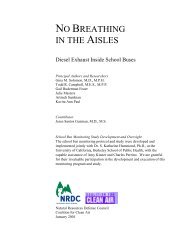Chile FActS - Natural Resources Defense Council
Chile FActS - Natural Resources Defense Council
Chile FActS - Natural Resources Defense Council
Create successful ePaper yourself
Turn your PDF publications into a flip-book with our unique Google optimized e-Paper software.
at the same time that a balance must be struck that maintains<br />
affordable energy prices and a stable investment climate.<br />
Unfortunately, the law struck the wrong balance by failing<br />
to create sufficient demand and missing the opportunity<br />
to create the conditions for significant numbers of NCRE<br />
companies to enter the market.<br />
In principle, the law creates demand for NRCE by<br />
requiring that an increasing percentage of energy in <strong>Chile</strong> be<br />
generated from NRCE technologies (5 percent from 2010 to<br />
2014 and then increasing 0.5 percent per year to 10 percent<br />
in 2024). However, according to an analysis commissioned<br />
by the <strong>Chile</strong>an Association for Renewable Energy (ACERA),<br />
the actual demand created is much less because a large<br />
percentage of the energy generated in <strong>Chile</strong> (estimated to be<br />
60 percent in 2011, 40 percent in 2015 and 10 percent in<br />
2020) is exempted from the law. 2,3 This unfortunate result is<br />
due to the fact that the “transitional” provisions of the law<br />
exempt certain long term energy contracts entirely and cap<br />
the NCRE requirement of others at a tiny 5 percent. It takes<br />
a long term, steady stream of income to attract investors to<br />
new market like NCRE in <strong>Chile</strong>, so taking these contracts<br />
off the table means that there are far fewer opportunities for<br />
PAge 5 | NRDc <strong>Chile</strong>’s Clean Energy Future<br />
the new market entrants proposing NCRE technologies.<br />
<strong>Chile</strong>’s dominant energy companies are very profitable in<br />
the current environment of high energy prices and have<br />
little appetite or incentive to invest in NCRE technologies<br />
or permit significant competition. For these reasons, <strong>Chile</strong>’s<br />
market, with all of its superb NCRE resources and market<br />
sophistication, languishes far below its potential.<br />
Mining and Solar: Perfect Together<br />
BNEF research reveals that a photovoltaic project in the Atacama Desert<br />
is expected to produce energy at a price competitive with coal and gas<br />
when its first phase is completed in late 2011. This plant, developed by the<br />
Spanish company Solarpack in a joint venture with <strong>Chile</strong>an state-owned<br />
copper company CODELCO, is expected to generate 2,690 MWh per year<br />
and will be financed without subsidies or specific tax benefits for solar<br />
energy. BNEF concludes that this is possible because northern <strong>Chile</strong> has<br />
some of the best solar resources in the world. Deployment of solar at<br />
scale in the mining sector could reduce demand for thermal generation and<br />
lower energy costs and environmental impacts. Based on BNEF’s global<br />
research, increased deployment of PV solar technologies at a large scale<br />
accelerates local cost reductions for the technology and BNEF expects this<br />
pattern to repeat in <strong>Chile</strong>.
















